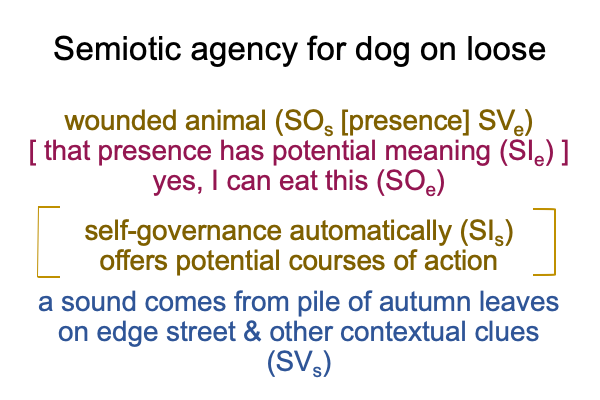0909 The introduction (section 7.1) does not disagree.
To me, it seems that the label for the contiguity between SOs and SVe could be changed to “potential meaning”. [Presence] is rich with “potential meaning”. So is the moniker, “information2b“.
0910 At the same time, the introduction (section 7.1) does not agree.
0911 The author claims that “meaning” associates to how an organism interprets a sign.
Surely, that claim coheres to the SIs. Or, maybe it goes with the SIe.
0912 Also, the author is interested in writing about resources that are not meaningful, but can be meaningful when an organism happens to discover that they have um… meaning2c.
Sign-relations are essential for the discovery of signification.
So, the author figures that there are potential meanings (where an entity can become meaningful to a semiotic agent) and potential signs (where an entity can come to the attention of a semiotic agent).
The author offers a table to distinguish proper meanings and signs from potential meanings and signs.
Finally, section 7.1 concludes that organisms can actualize potential meanings (and potential signs) by integrating them into their own goal-directed activities, especially when those activities are phenotypic (hence, adaptive in Umwelts past).
In section 17.2, the author develops the theme of form within a sign-relation.
The argument is theoretical.
0913 So, allow me to return a previous example.
A revision is in order.
0914 One fine morning, an unattended dog wanders the streets of my town, looking for what?… a potential sign? No. It is looking for a message, in the form of a SVs.
This unfamiliar dog is not an idealist. Or maybe, the dog is an idealist, because the dog is certain that a form is nearby, and that he can sink his teeth into that form. Not so much to chew, as to swallow.
0915 No sign-vehicle sends that interventional sign-object (SOi) until a sound, emanating from a pile of leaves, sends a message… er… a specifying sign-vehicle (SVs).
0916 Here is Sharov and Tonnessen’s noumenal overlay for semiotic agency as a generalization of this canine organismin a semiotic context.

0917 In section 7.3, titled “Semiotic Agency in Biosemiotics”, Sharov references his groundbreaking 2021 work with Tonnessen. The idea that semiotic agency is contained within biosemiotics is broached, but not with the verve of the above figure, which derives from Razie Mah’s examination of Sharov and Tonnessen’s 2021 text.
0916 “Semiotic agency” is no longer a label. It is a technical tool for biosemiotics. The utility of this tool is yet to be determined. However, what this examination finds is significant.
Semiotic agency reifies specifying and exemplar sign-relations. At the same time, semiotic agency draws upon an interscope that parallels the scholastic interscope for how humans think.
So, there are several key phenomena to consider. The first is an initiating semiotic event2a (SVs) that parallels sensation2a. The second is information2b (SOs [presence] SVe) that parallels perception2b. The third is a goal or aim2c(SOe) that parallels judgment2c.
0917 Does that reduce semiotics to a tool, as noted in section 7.4?
I guess that sign-relations are tools in the same way that a dog’s snout (one side fitted for detection and the other side fitted for biting into the detected thing) is a tool.
I prefer to use the terms, “adaptations” and “phenotypes”.
0918 So, how should biosemioticians conceptualize potential meanings and potential signs (section 7.5)?
Take a look at the preceding figure.
What is in the pile of leaves?
A potential sign?
The sound and, with investigation, odor coming from a pile of leaves2a (SVs) stands for an animal2b (SOs) in regards to the wandering dog’s detecting3b something going on in a pile of leaves1b (SIs).
0919 What is salient (SIe) about this hidden animal (SOs)?
May I also ask, “What is the potential meaning of this hidden animal?”
The dog burrows into the leaf pile for further information2b. The animal may be wounded2b.
Well, that means it2b (SOs) is not going to fight back2b (SVe). So, the dog’s goal module3c((1c)) (SIe) says, “Yes, I can put this in my mouth.”2c (SOe).
